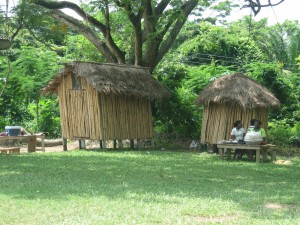How understanding the biology of the crop can help us reduce losses of yams during on-farm storage in West Africa
By Dr. Debbie Rees, Natural Resources Institute, University of Greenwich, UK

This post is part of the ADM Institute’s #PreventPHL blog campaign, following up on the First International Congress on Postharvest Loss Prevention. To read more posts in the series, click here.
Yam (Dioscorea spp) is a key staple crop in West Africa. Tubers may be stored for several months on-farm, but it is estimated that 10-50% of tubers are lost during this time. The Natural Resources Institute is working with the Council for Scientific and Industrial Research (CSIR – Crop Research Institute and CSIR – Food Research Institute) in Ghana and with the National Root Crop Research Institute (NRCRI) in Nigeria to identify strategies to reduce these losses. As the farmers have very few resources, the main strategy that we are following is to use knowledge of the postharvest biology of the crop to optimise handling and storage conditions.
Storage losses can be reduced by exploiting the natural reaction of tubers to heal their wounds
Wounds incurred during harvest have a significant impact on rates of deterioration as they increase rates of water loss, causing tissue stress, and provide a route for infection by rotting pathogens.
As for many other root crops, yam tubers are able to heal wounds even after the plant has been harvested. The practice of “curing” root crops involves placing the crop under conditions that are most favourable for wound healing for a few days immediately after harvest. For potato tubers in developed countries, this involves keeping tubers at temperatures of approximately 15°C, and high humidity (to prevent surface tissues of wounds desiccating), for 7-10 days before low-temperature storage.
For yam tubers on-farm an appropriate curing method is to maintain high humidity for 10-14 days prior to placing tubers in the more ventilated lower humidity environment necessary during long-term storage to discourage rot growth. The necessary high humidity conditions can be maintained simply by covering the tubers with woven sacking material. Condensation must be avoided as this promotes rot growth, and in practice, this means avoiding the use of materials such as plastic sheeting.
On-station trials have been carried out in which we have been able to demonstrate a reduction in losses of more than 15% by implementing this curing strategy. On the basis of this on-farm trial have now been initiated in Ghana and in Nigeria. These are at an early stage, but from initial data, we anticipate a reduction of rotting losses by approximately 10%.
Storage life of yam tubers can be extended by designing storage structures to improve the storage environment
There have been previous attempts to improve the storage structures for yam tubers. The most important issues are to maintain a level of ventilation, protect from the sun and from rain and critically to protect against rodent attack. The major constraint to improving the storage structures is cost. Storage engineers at CSIR Crop Research Institute have adapted earlier wooden designs to use locally available materials, and thereby bring the cost into a range that is feasible for farmers. On-farm testing of these designs has shown that compared to traditional stores both tuber weight loss is reduced and rates of rotting are reduced.
Training of extension officers and of farmers to understand the postharvest behaviour of their crops has enormous potential to reduce losses but strategies need to be developed to disseminate ideas clearly and robustly.
The PHL 2015 Congress provided a valuable forum for postharvest scientists to swap ideas and experiences. In many cases, the technology needed to reduce losses is known. The challenge is to implement strategies appropriate to the developing world context. Sharing experiences avoiding the repetition of error can significantly speed up advances.
The blog entries in this #PreventPHL series are by students and members of the PHL Prevention community of practice. The opinions expressed are those of the individual authors and do not necessarily reflect the position of the ADM Institute. In addition, none of the statements should be considered an endorsement of any person, product, or technique by the ADM Institute.
